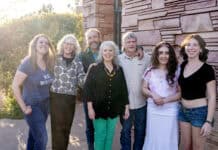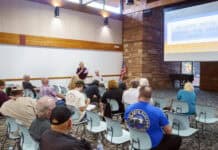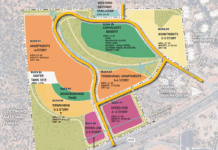By Susan Johnson
A search that began on April 19, after the Coconino County Sheriff’s Office received a report of a severely damaged aircraft found in the forest, finally yielded some answers on Friday, April 24.
The downed aircraft was reported to be in the Secret Canyon Wilderness Area, within Coconino County and between Sycamore Canyon and Oak Creek Canyon, according to Gerry Blair, public information officer for CCSO.
A door from the airplane wreckage was found and its serial number run through a national aircraft database, Blair said, coming back as tail number N2700Q matching that of the long-missing aircraft piloted by 54-year-old William Westover and carrying 43-year-old passenger Marcy Randolph.
The two departed the Deer Valley Airport, 15 miles north of downtown Phoenix, on Sept. 24, 2006 on a sightseeing flight to Sedona in Westover’s 230 HP Cessna 182K.
According to the National Transportation Safety Board, at the time winds were at 14 knots, gusting to 18 and there were 10 miles of visibility at the weather observation point in Flagstaff.
Also recovered were the skeletal remains of what are believed to be Westover and Randolph.
The remains have been transported to the Coconino County Medical Examiner’s office where Coconino County Sheriff’s detectives and forensic investigators will attempt to identify them.
The crash site is located in a remote area not accessible by vehicles.
Agencies involved in the recovery effort include the Coconino County Sheriff’s Office, the Coconino County Sheriff’s Search and Rescue Unit, the Yavapai County Sheriff’s Office, the Yavapai County Sheriff’s Search and Rescue Unit, the Arizona Department of Public Safety Air Rescue Division, the Arizona Division of Emergency Management, and the Civil Air Patrol.
When the couple first went missing more than two years ago, Tom Newman of Sedona Sky Treks flew Randolph’s father in an extended effort to find the man’s daughter.
“We’re real familiar with this case,” Newman said. “Marcy’s father, Phil Randolph, was here the day after the plane went missing and we offered to assist, flying along with Maverick Helicopters.”
After meeting with the family, Newman flew Randolph half a dozen times to the area where radar contact was lost.
The Civil Air Patrol searched as well, calling off the hunt a month after the airplane was reported missing.
As a commercial pilot, Newman has over 8,000 hours of flying experience, 5,000 hours in Sedona.
Part of the problem in finding downed aircraft is the severe terrain in the area, Newman explained.
“Some of the vertical canyons are steep and deep and depending on how the aircraft impacted, it could be wedged into a narrow canyon,” he said. “A 182 can travel at 100 mph and it will compact itself pretty well.”
According to public statements made by Phil Randolph, hikers reported a small fire on the same day the plane disappeared, less than three hours after it went off radar and in approximately the same location.
However, at the time, no one connected the fire and the missing aircraft probably because there were no common agencies involved.
According to Public Infor-mation Officer Gary Johnson of the Sedona Fire District, it is not common practice for the district to be advised of missing aircraft, although they occasionally know of those circumstances through news reports.
Tapes from SFD’s call center on Sept. 24, 2006, are no longer available; however, if the fire report was made to SFD, it would have been referred to Coconino County or the U.S. Forest Service since the fire was outside of the district’s jurisdiction, Johnson said.
Randolph wants to see more coordinated communications among agencies in the future.
“Although the search for N2700Q is over, we know that other planes will fall, and that other families will suffer,” Randolph said. “It is for them that we will now begin a new search; a search for answers to hard questions that arose about how the official search was managed, and statements made by public officials involved in that search. We hope the answers to these questions will lead to improvements in the responsiveness of our public agencies, the manner in which they communicate with each other, and ultimately the effectiveness of future searches.”
Randolph also stated that he and Jayne McElfresh were the first to spot the wreckage site last week although they did not initially approach it.
They were aided by research conducted by Chris Killian, a volunteer who searches for missing aircraft, who also contacted the hikers who originally reported the fire in 2006.
According to Randolph, the hikers returned to the scene and were the first to find physical evidence of the wreck.
The information provided by Randolph was not included in public statements by CCSO and Blair would not confirm its accuracy.
Questions submitted to the Sedona Airport and Red Rock Ranger District were not answered prior to deadline.
Susan Johnson can be reached at 282-7795, ext. 129, or e-mail sjohnson@larsonnewspapers.com


















